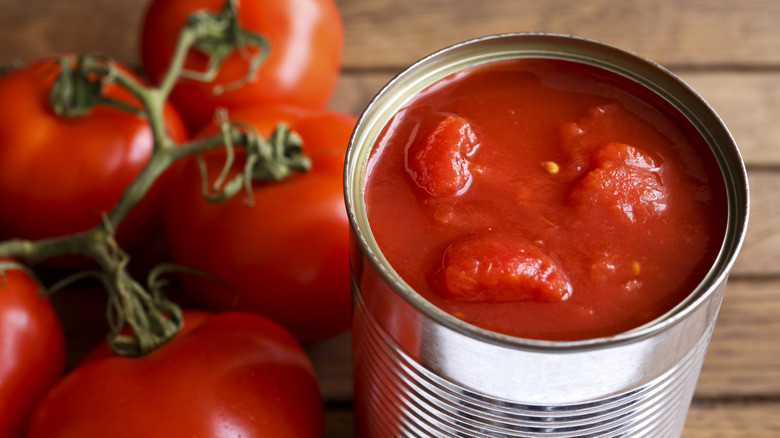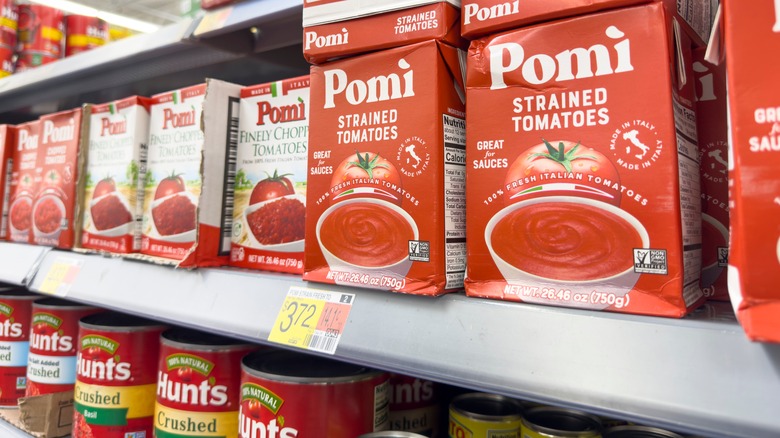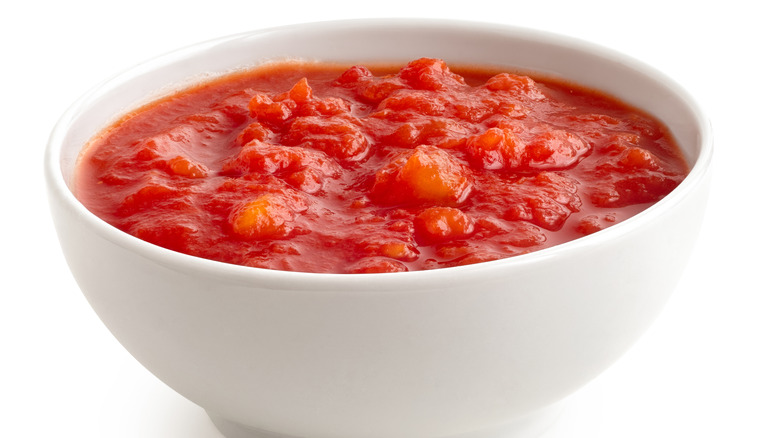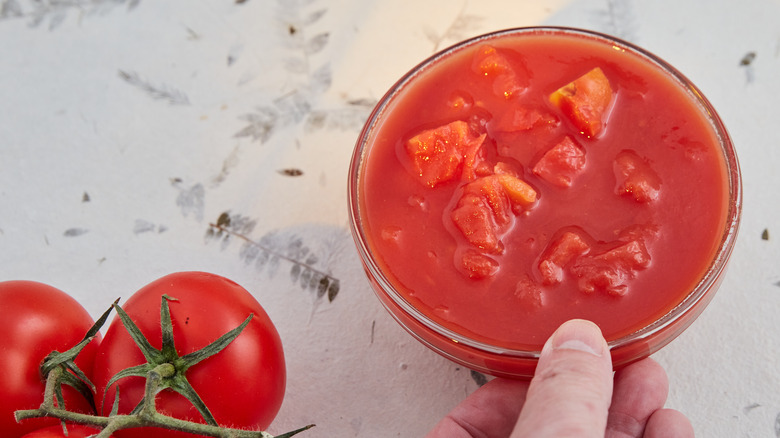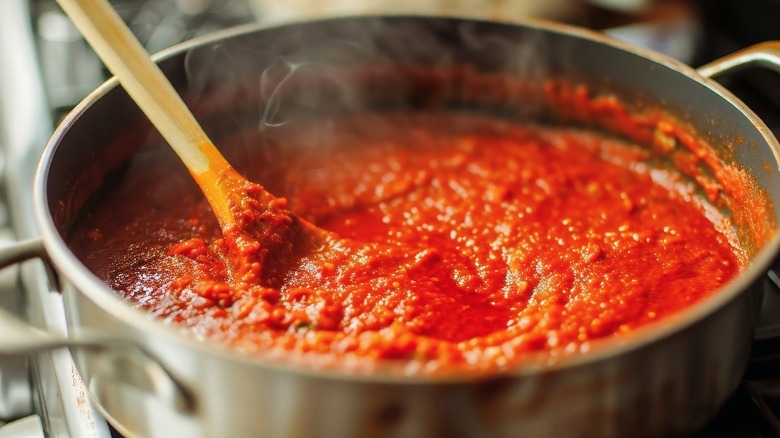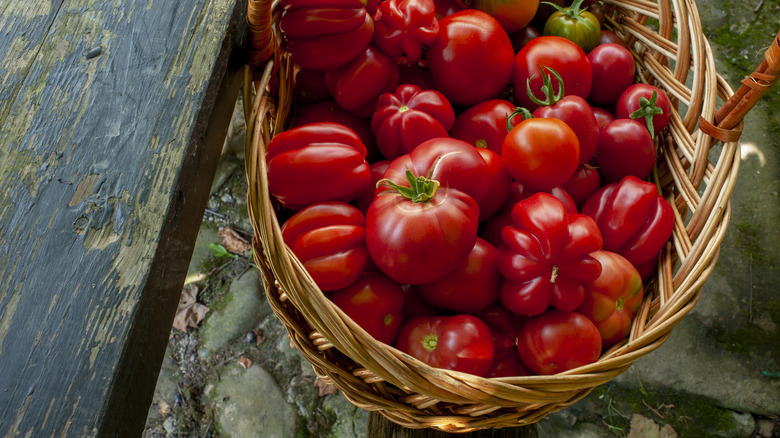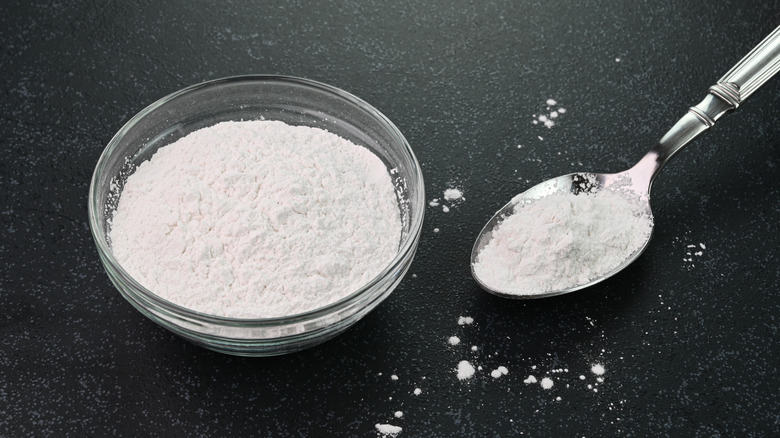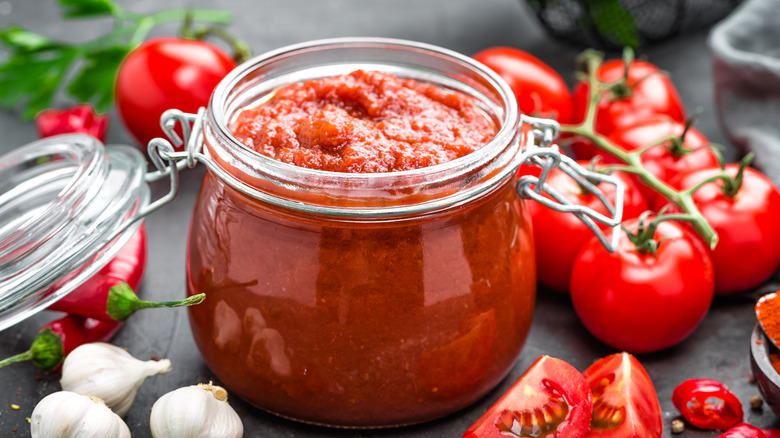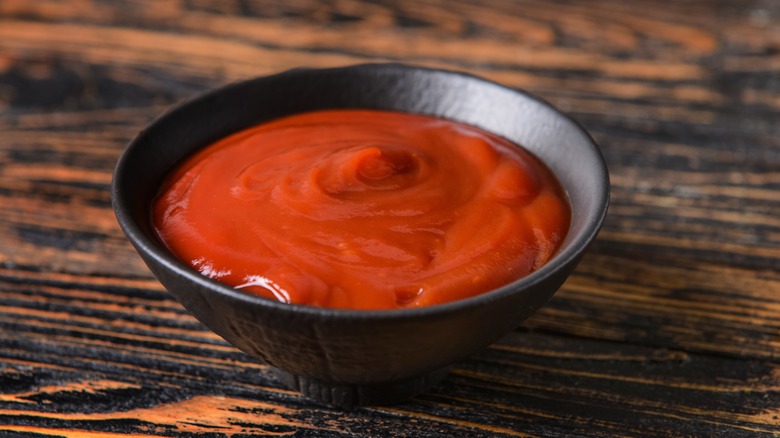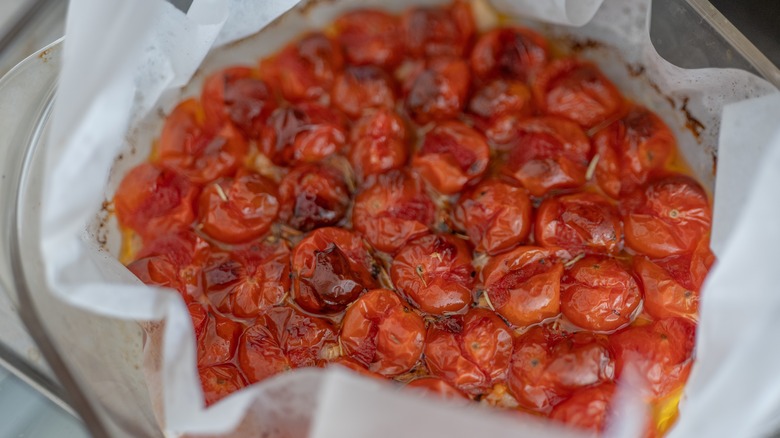Mistakes Everyone Makes With Canned Tomatoes
We may receive a commission on purchases made from links.
Canned tomatoes are something everyone should have in their pantry. You can use them to make a rich, slow-simmered tomato sauce, whip up a salsa, or add to soups and stews. They're extremely versatile and can help you throw together a meal when you feel like you don't have much food in the house. However, there are mistakes everyone makes with canned tomatoes that can put people off.
If you think you're not a fan of canned tomatoes, you might have made some of these common errors. Perhaps you didn't know about the types of canned tomatoes available and how they make a difference to the dish you're making. Or, maybe you never cook them for long enough, meaning you don't get a chance to concentrate their flavors and make them tastier. These missteps and more can lead to a subpar meal.
Anyone who's sick of canned tomatoes that taste metallic or insipid would do well to check out these pitfalls. Not only will we tell you the mistakes you might be making with canned tomatoes but we've got some tips on how to fix them or avoid them altogether. This will leave you making better dishes — and who doesn't want that?
Not knowing the difference between types of canned tomatoes
There are many types of canned tomatoes, and if you don't know the difference between them, you might end up using the wrong ones for the recipe. Perhaps the three most common types are whole, diced, and crushed. But, you can also expand your horizons further.
Whole canned tomatoes are, as the name suggests, whole. They're usually plum types, such as Roma or San Marzano, and are peeled to improve the texture of dishes. For many people, these are the go-to canned tomatoes. They tend to be of better quality overall and you can chop, blend, or crush them yourself to get the texture you want, making them versatile.
Crushed tomatoes are essentially crushed whole tomatoes. They cook down into sauces quicker than whole tomatoes and save the work of crushing them yourself. The downside is that you can't control the texture and they can come anywhere from practically puréed to fairly chunky, depending on the brand, so you may not know what to expect.
Diced tomatoes have been chopped into chunks. They usually contain additives to help them retain their shape, which is good if you want chunks of tomato in your finished dish, but unhelpful if you want them to break down into a sauce.
Another notable canned tomato variety is fire roasted. These have been roasted over flames before canning to give them a charred smokiness and a more concentrated flavor.
Thinking all brands of canned tomatoes are equally good
Maybe you've finally got your head around the different types of canned tomatoes, but don't assume every brand is equally good. For instance, some whole tomatoes are amazing, while others are far from flavorful. This might leave you worried about whether you're about to buy a dud. If in doubt, pricier cans are usually of good quality. However, you can find some affordable gems too.
We put together a list of canned tomato brands ranked worst to best that might help you out. Despite being a popular brand, Hunt's didn't impress us much. Their tomatoes tend to be thin and watery and some varieties contain salt, which is unnecessary as it's better to just add your own. Contadina is another brand that doesn't live up to the hype. They're too sweet and don't taste particularly good overall.
On the other end of the spectrum, Bianco DiNapoli tomatoes were our overall favorites. They're made using tomatoes grown organically in Yolo County, California, and they really deliver on flavor. San Merican tomatoes are another option among our favorites. They're made using the San Marzano variety of tomatoes but these toms are grown in the U.S.A. This means they don't get to use the San Marzano name, but you get great tomatoes with fewer food miles, which can't be all bad.
Using canned tomatoes raw
You eat tomatoes raw, so why wouldn't you eat canned tomatoes raw? Well, it's not exactly the same thing. If you want the best flavor, you should think twice about eating canned tomatoes without cooking them.
It's not that it's dangerous to eat tomatoes straight from the can. It's absolutely fine to do so. But they're not quite raw but not exactly cooked, so you get the worst of both worlds. During the canning process, tomatoes are steamed or blanched to help remove the skins. The cans are also heated after being sealed to sterilize the contents. This effectively lightly cooks them.
The consequence of this is that they no longer have the fresh flavor of raw tomatoes, nor do they have the complex richness of tomatoes that have been cooked for a long time. So, if you eat them without cooking them or add them straight into a no-cook dip or sauce, they don't taste amazing. They can be watery and tasteless or overly acidic without enough sweetness.
Draining canned tomatoes before cooking with them
If you drain canned tomatoes before using them and pour that liquid straight down the drain, you're making a mistake. In many cases, you can pour the whole can of tomatoes into a recipe, liquid and all, and you'll only boost the flavor. Or, in cases where you want to keep the liquid to a minimum, you can keep that juice and use it for something else.
There's no good reason to drain your canned tomatoes and throw out the juice. In a lot of dishes, that juice just adds to the flavor. For instance, if you're making a soup or stew, you can use all the liquid from your canned tomatoes and slightly reduce the amount of water or stock you add. This way, you get the same amount of liquid but more tomato flavor. Or, when you're making a pasta sauce, you can cook it for longer without it drying out if you add the juice.
However, there are some occasions when the juice will make a recipe too watery, for instance, when making salsas or certain dips. Or, if you're roasting your canned tomatoes, you'll need to drain them. But you still don't need to waste that precious juice. You can use it in other ways, such as adding it to soups or stews or drinking it in bloody Marys.
Not cooking canned tomatoes for long enough
When you use canned tomatoes, it's important to cook them long enough. Many people make the mistake of rushing the process, but if you don't give canned tomatoes the time they need to simmer, your dish won't turn out as tasty as it could be.
Due to the processing that canned tomatoes go through, they can taste a bit sharp or acidic when you first open them up. If you don't cook them long enough, that sharp taste sticks around. Simmering the tomatoes for a while helps to do away with that "canned" flavor, making them taste smoother and richer.
Another reason to cook them longer is to deepen the flavor. The cooking process evaporates some of the moisture, concentrating their flavor and bringing out their natural sweetness. While they're cooking, tomatoes also blend with the flavors of the other ingredients in the recipe, like herbs, garlic, or onions. If you don't give the dish enough time, you miss out on all those delicious flavors coming together. A quick-cooked sauce will taste raw or unbalanced, and you might find yourself adding too much sugar or salt to fix it.
Cooking canned tomatoes for at least 30 minutes lets the flavors develop. However, some recipes call for 3 or more hours of simmering. You can let them simmer while you work on other parts of the meal. By the time you're ready to serve, the dish will be rich, flavorful, and far tastier than if you rushed through it.
Substituting fresh tomatoes for canned tomatoes in recipes
You might think that using fresh tomatoes instead of canned ones in a recipe is pretty much the same thing. But, there's a difference between fresh and canned tomatoes and you can't expect the same results. Or, perhaps you might even assume that fresh tomatoes will make your recipe even better — but this is also a misconception.
Fresh tomatoes are less concentrated than a tightly-packed can, so you might need more of them than you'd imagine. If they're low-quality or out of season, they may also be less flavorful than canned varieties, so bear this in mind. Plus, canned tomatoes are peeled, so you'll either need to peel fresh tomatoes or deal with skin in your finished dish. Frankly, it's simpler to just use canned tomatoes.
And, conversely, you shouldn't use canned tomatoes in most recipes that call for fresh ones. Fresh tomatoes have a different flavor and more bite to them. Use canned tomatoes in a pico de gallo, for instance, and you'll have a very different dish compared to one made with fresh tomatoes. A like-for-like substitution usually doesn't work.
Not using baking soda to cut the acidity of canned tomatoes
Tired of canned tomatoes that are overly acidic? Well, if you're not using baking soda to cut through the acidity of canned tomatoes, you're making a mistake. Yes, it's the same ingredient you use in your favorite cake recipe, but it works wonders in balancing out the sharpness of tomatoes. It works because baking soda is alkaline, so it neutralizes acids. Since canned tomatoes are naturally acidic, adding a little baking soda helps reduce that sour taste.
To begin with, don't add too much. A small pinch is a good place to start. Stir it in, and you'll see the sauce bubble a bit. This is the reaction between the acid in the tomatoes and the baking soda. After the bubbles die down, taste your sauce. You should notice that it's less tangy and has a smoother flavor. If it's still too acidic, you can add another small pinch, but you can't take it away so be careful not to overdo it. Adding too much baking soda can make your sauce taste off or even a bit soapy.
This trick is great because it helps you balance out the acidity without having to rely on sugar or other ingredients that could change the taste of your dish. It's a quick and easy fix for when your sauce doesn't taste quite right, and you probably already have baking soda in your pantry.
Under seasoning or over seasoning canned tomatoes
It's equally easy to add too much seasoning or not enough when you're cooking with canned tomatoes. Both are bad in different ways, but over seasoning is more likely to result in a dish that's inedible. You can learn how to season more effectively to avoid this problem in the first place but it's also fixable if you've already done it.
If you're making a sauce with a 28 ounce can of whole tomatoes, you'll probably need around a teaspoon of salt. But, there are variables involved and this is where it's easy to over or under season your dish. For instance, if you use kosher salt or flaked sea salt, you'll need to use more than if you use table salt or finely ground sea salt, because it takes up less room in a measuring spoon. If you're adding water to the dish, this will dilute it, so you'll likely need more salt. However, adding other salty ingredients — such as stock, capers, or cheese — will mean you should reduce the salt. Plus, some canned tomatoes are already salted, meaning you might need to omit the salt from your recipe altogether.
Taste for salt as you go along, starting conservatively and adding more if you need it. If you end up with an overly salty dish, your best bet is to dilute it. Add more canned tomatoes and any other seasonings aside from salt.
Storing leftover canned tomatoes incorrectly
When you open a can of tomatoes but don't use the whole thing, it's important to store the leftovers properly. This helps keep them fresh and safe to eat. But, you might be surprised at how many people get this wrong.
First, don't store the tomatoes in the open can. Once a can is opened, the metal can react with the tomatoes, which can affect the flavor. Instead, transfer the leftover tomatoes to an airtight glass or plastic container. If you plan to use them soon, you can keep them in the fridge. They should last for about 5 to 7 days there.
If you don't think you'll use the tomatoes within a few days, freezing is a better option. You can freeze canned tomatoes for at least 2 to 3 months. To do this, place them in a freezer-safe container or bag. Some people prefer to blend tomatoes before freezing them to save space and so freezing doesn't affect the texture. Label the container with the date, so you know how long they've been in the freezer.
Failing to add sugar when using canned tomatoes in recipes
You might think that adding sugar when cooking canned tomatoes is cheating; that it's a shortcut to making a sauce more flavorful that you shouldn't need if you get it right. But, actually, it's a mistake not to add sugar when you use canned tomatoes in a recipe.
Most chefs agree that a little bit of sugar is just the thing for balancing out the acidity in canned tomatoes. But, even if you cook them for a long time to get that deliciously concentrated richness, you still need some sugar for sweetness. There's nothing wrong with it. Even the iconic chef Marcella Hazan, who was credited with bringing the authentic taste of Italian food to America in the '70s, used sugar in her tomato sauce. And you can't argue with that kind of authority.
Generally, you'll need roughly a teaspoon of sugar for every 28-ounce can of tomatoes you use. However, you might end up needing slightly more or less, depending on the sweetness of the tomatoes (this can vary batch-to-batch, even within the same brand) and what other ingredients you're using. Start with just under a teaspoon of sugar and then continue adding it to taste.
Leaving cheap canned tomatoes whole
If you're working with cheap canned tomatoes and want to improve their texture and flavor, blending them is an easy trick. Cheap canned tomatoes are sometimes part chunky, part watery, which isn't ideal. By blending them, you can create a more consistent texture that makes the sauce better.
There's also the fact that some cheap tomatoes have additives in them that mean they don't properly melt down into recipes, even when simmered for a long time. Blitzing them gives them a head start, breaking them down before they've even hit the pan. You can adjust how much you blend them, keeping them slightly chunky if you want to.
Blending can also help bring out the flavor of the tomatoes if you know what to add. Sometimes cheap canned tomatoes don't have the same rich taste as more expensive brands. Blending them with some sugar or even some carrot for sweetness improves the flavor.
Want to give this a try? Simply pour the tomatoes into a blender or use an immersion blender. Whizz them up until they reach the consistency you want. A quick blend can turn them into a smooth sauce that's perfect for using in pasta, pizza, or soups. It's a simple trick but one that can make a big difference.
Not roasting canned tomatoes to concentrate the flavor
Many people think that roasting is just for fresh tomatoes, but this is a mistake. You can also roast canned tomatoes. It intensifies the flavors and makes them taste better. Once roasted, they're also more versatile. When you roast tomatoes (and any other veggies) some of the moisture contained within them evaporates. This means you're left with a more concentrated flavor. Once roasted, canned tomatoes somehow taste simultaneously sweeter and more savory.
Although you can roast crushed or diced tomatoes, it's better to use whole ones — either regular whole plum tomatoes or canned whole cherry tomatoes. Start by draining them — you can reserve the liquid to use in another recipe — then roughly halve them and remove the seeds. Bake them at a low temperature (around 300 degrees Fahrenheit) for at least an hour until they look slightly dried on the outside but are still moist inside. They may darken in color slightly.
After cooking them this way, you can use them to make salsa, add them to sauces, eat them in sandwiches, or use them as a pizza topping. They're much more intensely flavored than regular canned tomatoes, so you can use them in more ways.
